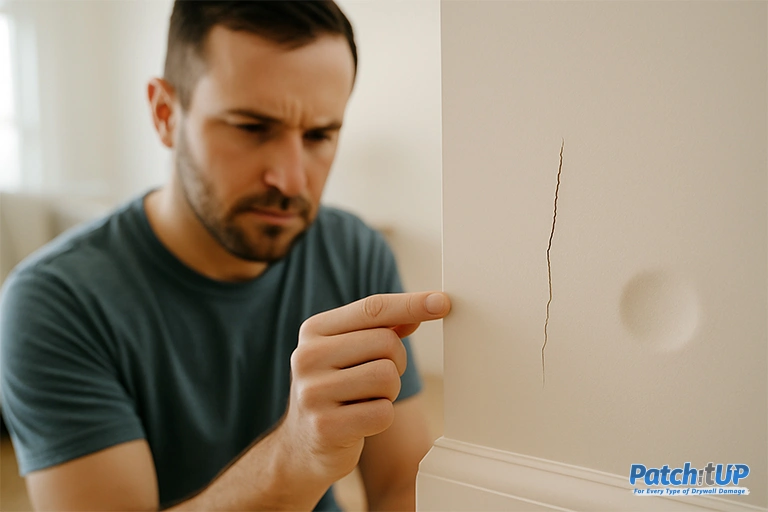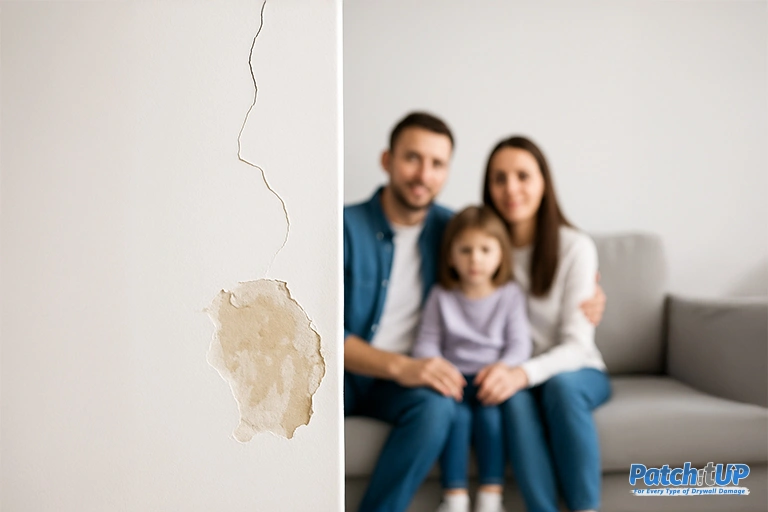Drywall Maintenance: Becoming a new homeowner is a major milestone, and with that excitement comes a range of new responsibilities—one of which is taking proper care of your home’s interior walls and ceilings. A large portion of your home’s interior is likely covered in drywall, and understanding how to maintain it can help prevent long-term damage, reduce repair costs, and keep your home looking clean and fresh.
Despite its strength and adaptability, drywall can be destroyed. If not properly maintained, it may get mold, water damage, cracks, or dents. This comprehensive guide covers the definition of drywall, the importance of upkeep, and the doable actions you should take to keep it in good condition over time.

1. What Is Drywall and Why Is It Important?
Drywall—also known as plasterboard, wallboard, or sheetrock—is a flat panel made of gypsum (a type of mineral) pressed between thick sheets of paper. It’s used to build walls and ceilings in most modern homes due to its affordability, smooth finish, and easy installation.
Drywall not only shapes the interior of your home but also plays a role in insulation and fire resistance. It may, however, be susceptible to harm from impact, moisture, and normal house settling. For this reason, every homeowner must know how to maintain drywall properly.
2. Watch for Cracks, Dents, and Surface Imperfections
Even in a brand-new home, drywall may begin to show small cracks or indentations as the building naturally settles or due to temperature and humidity fluctuations. Although these flaws are frequent and not always dangerous, they can get worse over time if ignored.
What you should do:
- Inspect regularly: Look at corners, ceiling lines, and joints between drywall panels for small cracks or lines.
- For minor cracks or dents: Use spackle or joint compound to fill them in. Let the compound dry, sand it down, and repaint the area.
- For larger holes: Use a drywall patch kit, which includes mesh and compound to cover the area securely.
Being consistent with small repairs helps maintain the appearance of your walls and prevents further damage from spreading.
3. Protect Against Moisture and Water Damage
Drywall is particularly sensitive to moisture. If it comes into contact with water through leaks or high humidity, it may absorb moisture, which could lead to warping, swelling, or the development of mold. Sometimes drywall damaged by water needs to be replaced entirely.
What you should do:
- Keep an eye out for signs of moisture, such as water stains, soft or protruding areas on the wall, musty smells, or visible mold.
- Address the source immediately: Whether it’s a leaky roof, burst pipe, or plumbing issue, fixing the leak quickly is crucial.
- Use moisture-resistant drywall: For bathrooms, basements, and laundry rooms, consider replacing regular drywall with green board or cement board, which are designed to resist moisture.
Regularly monitoring moisture-prone areas can help you act before the damage becomes costly or harmful to your health.
4. Clean Walls Carefully Without Damaging Them
Dust, fingerprints, and everyday smudges can accumulate on drywall, especially in high-traffic areas like hallways and children’s rooms. Cleaning drywall requires a gentle approach to avoid damaging the paint or surface.
How to clean drywall properly:
- Start with a dry microfiber cloth or duster to remove loose dust.
- Use a soft sponge with warm water and mild dish soap to remove smudges or marks. Wring out the sponge so it’s damp, not soaking wet.
- Avoid harsh scrubbers, steel wool, or strong chemical cleaners, as they can scratch or discolor the wall surface.
- For stubborn stains, mix water with a little baking soda to create a gentle cleaning paste.
Cleaning walls gently but regularly keeps your interiors looking fresh and extends the life of your paint and drywall finish.
5. Handle Nail Pops and Seams Promptly
As your home settles over time, the nails or screws securing the drywall may begin to push out slightly, creating small bumps or “pops” on the wall surface. This is a common issue, especially in newer homes.
Fixing nail pops and seams:
- Tap the popped nail or screw back into the wall using a hammer or screwdriver.
- Add a new drywall screw slightly above or below the original for added support.
- Apply joint compound over the area, smooth it out, let it dry, sand it flat, and repaint.
Regularly checking for and fixing nail pops prevents minor issues from becoming noticeable defects in your walls.
6. Repaint for Protection and Aesthetics
Paint not only makes your walls look beautiful, but it also serves as a layer of protection for the drywall underneath. Over time, paint can fade, peel, or wear down due to sunlight, moisture, and general wear and tear.
Tips for repainting:
- Clean the surface first to remove dust and grease.
- Patch and sand any imperfections before applying new paint.
- Use a primer if you’re covering a dark color or patching large sections.
- Choose high-quality paint with moisture and stain resistance, especially for kitchens and bathrooms.
Repainting every few years helps maintain your home’s interior appearance and protects the underlying drywall.

7. Know When to Call a Professional
While small drywall issues can be handled on your own, larger problems may require a professional touch. Issues like large holes, major water damage, or mold growth should be addressed by an experienced drywall repair specialist.
Signs you may need professional help:
- Deep or widespread cracking
- Extensive water damage or mold
- Loose drywall or sagging ceilings
- Repeated patching that doesn’t last
Professional drywall repair ensures safety, durability, and a seamless finish that blends with your existing wall.
Final Thoughts
One of the most crucial but doable chores for a new homeowner is drywall maintenance. Your drywall may continue to look its best for decades with routine inspections, prompt repairs, meticulous cleaning, and appropriate moisture protection. You can preserve your investment and keep your living area hygienic, safe, and appealing for many years to come by being proactive and knowing the fundamentals of drywall maintenance. Start taking care of your drywall right away rather than waiting for a minor crack to grow into a major issue.
FAQ for What You Need to Know About Drywall Maintenance!
Q1: What do I need to know about drywall?
Drywall is a building material used to create walls and ceilings. It’s made of gypsum plaster between two sheets of paper. It’s easy to install, paint, and repair.
Q2: How do you know when drywall needs to be replaced?
Replace drywall if it has large cracks, sagging, mold, water damage, or holes that can’t be patched easily.
Q3: Clean the damaged area first. Before applying a patch or compound, sand the surface lightly and remove any loose material.
Q4: What safety precautions should you take when working with drywall?
Wear a dust mask, goggles, and gloves. Work in a well-ventilated space and avoid breathing in drywall dust.
Related Post :
- 2025 Guide to Eco-Friendly Drywall and Insulation Materials!
- Top 5 Drywall Trends of 2025: Textures, Finishes & Soundproofing Solutions!
- DIY vs. Professional Drywall Repair: What’s Right for You?

Leave a Reply